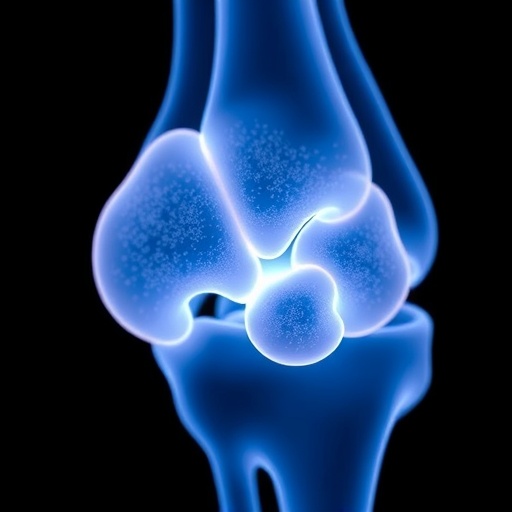In recent years, the realm of regenerative medicine has witnessed remarkable advancements, particularly in the field of articular cartilage repair. Articular cartilage damage, often resulting from trauma or degenerative diseases such as osteoarthritis, poses significant challenges due to the tissue’s limited self-healing capacity. With the global increase in the aging population, the prevalence of cartilage-related ailments has reached alarming levels, compelling researchers to explore innovative therapeutic strategies. Among these, the use of ultramodern natural and synthetic polymer hydrogel scaffolds has emerged as a highly promising approach, offering new avenues for effective cartilage repair and regeneration.
Articular cartilage serves as a smooth, lubricated surface within joints, facilitating pain-free motion and load distribution. Damage to this tissue not only impairs joint function but can also progress to debilitating conditions that drastically reduce quality of life. Conventional treatment modalities, including microfracture surgery and autologous chondrocyte implantation, face limitations such as inconsistent outcomes and donor site morbidity. Tissue engineering, integrating cells, scaffolds, and bioactive molecules, has revolutionized the therapeutic landscape by providing an engineered microenvironment that fosters tissue regeneration.
Central to tissue engineering are cellular scaffolds, which provide a three-dimensional framework mimicking the native extracellular matrix (ECM). These scaffolds not only support cell adhesion, proliferation, and differentiation but also modulate the local biochemical and mechanical cues essential for cartilage tissue formation. Among the diverse materials explored, hydrogels—three-dimensional hydrophilic polymer networks—have garnered significant attention due to their inherent similarities to the natural ECM and their tunable properties.
Natural polymer hydrogels, derived from biomolecules such as collagen, hyaluronic acid, chitosan, and alginate, offer exceptional biocompatibility and bioactivity. Their structural similarity to ECM components enables superior cellular interactions and supports chondrogenesis. However, these natural hydrogels often suffer from limited mechanical strength and rapid degradation rates, which pose challenges for load-bearing applications such as articular cartilage repair.
Synthetic polymer hydrogels, on the other hand, encompass materials like polyethylene glycol (PEG), polyvinyl alcohol (PVA), and polylactic acid (PLA). These hydrogels are highly customizable in terms of mechanical properties, degradation kinetics, and crosslinking density, thereby overcoming the shortcomings of natural hydrogels. Nevertheless, synthetic polymers may lack inherent bioactive motifs required for optimal cell signaling, necessitating functionalization strategies to enhance their biological performance.
The fusion of natural and synthetic polymers has paved the way for hybrid hydrogels that harness the advantages of both material classes. By combining the bioactivity of natural polymers with the mechanical robustness and versatility of synthetic counterparts, hybrid hydrogels can create an optimal niche that supports sustained chondrocyte function and ECM deposition. Recent studies have demonstrated improved cartilage regeneration outcomes using such composite scaffolds, highlighting their translational potential.
Fabrication techniques play a pivotal role in defining hydrogel scaffold architecture and functionality. Techniques such as photopolymerization, ionic crosslinking, and enzymatic crosslinking enable precise control over hydrogel porosity, stiffness, and degradation rates. These parameters critically influence nutrient diffusion, waste removal, and cellular mechanotransduction—factors essential for successful tissue regeneration.
In addition to structural considerations, the integration of bioactive molecules including growth factors, cytokines, and gene delivery systems within hydrogel scaffolds has emerged as a transformative strategy. Controlled release of these agents from hydrogels can potentiate the recruitment of endogenous stem cells, stimulate chondrogenic differentiation, and modulate inflammatory responses, thereby enhancing the regenerative milieu.
Stem cell-based approaches complement hydrogel scaffold technologies by providing a versatile cell source capable of differentiating into chondrocytes. Mesenchymal stem cells (MSCs) sourced from bone marrow, adipose tissue, or synovium exhibit remarkable chondrogenic potential when cultured within conducive hydrogel environments. The encapsulation of stem cells within hydrogels not only protects them from hostile joint environments but also facilitates their localized delivery and differentiation.
The biomechanics of hydrogel scaffolds are particularly crucial given the dynamic loading conditions of articular joints. Recent advancements have yielded hydrogels with tunable viscoelastic properties that closely replicate native cartilage, enabling them to sustain repetitive mechanical stresses without compromising structural integrity. Such mechanically resilient hydrogels contribute significantly to restoring joint function and delaying osteoarthritic progression.
Despite these promising developments, challenges remain in translating hydrogel scaffold technologies from bench to bedside. Issues such as scaffold integration with host tissue, long-term durability, immune responses, and scalability of manufacturing processes warrant further investigation. Nonetheless, ongoing interdisciplinary efforts combining materials science, cellular biology, and clinical research continue to accelerate progress in this domain.
Looking forward, the future of articular cartilage repair lies in the design of “smart” hydrogel scaffolds capable of responding dynamically to environmental stimuli. These next-generation materials may incorporate sensors and actuators enabling real-time monitoring and modulation of the repair process. Moreover, advances in bioprinting technologies could facilitate patient-specific scaffold fabrication, enhancing therapeutic precision.
The convergence of molecular engineering, stem cell biology, and advanced fabrication processes heralds a new era in cartilage tissue engineering. Ultramodern polymer hydrogel scaffolds stand at the forefront of this revolution, offering hope for millions suffering from cartilage-related disorders. As research progresses, these scaffolds are poised to transform clinical approaches, providing durable, biocompatible, and efficacious solutions for cartilage regeneration.
In summary, the development of natural, synthetic, and hybrid polymer hydrogel scaffolds represents a critical milestone in regenerative medicine targeting articular cartilage repair. Their unique ability to recapitulate native tissue microenvironments, coupled with advances in cellular therapies and biomechanical engineering, underscores their potential to address a pressing clinical challenge. Continued exploration and optimization of these materials will be essential to unlock their full therapeutic capabilities and achieve widespread clinical integration.
Subject of Research: Articular cartilage repair and regeneration using natural and synthetic polymer hydrogel scaffolds.
Article Title: Ultramodern natural and synthetic polymer hydrogel scaffolds for articular cartilage repair and regeneration.
Article References:
Li, CS., Xu, Y., Li, J. et al. Ultramodern natural and synthetic polymer hydrogel scaffolds for articular cartilage repair and regeneration. BioMed Eng OnLine 24, 13 (2025). https://doi.org/10.1186/s12938-025-01342-3
Image Credits: Scienmag.com




